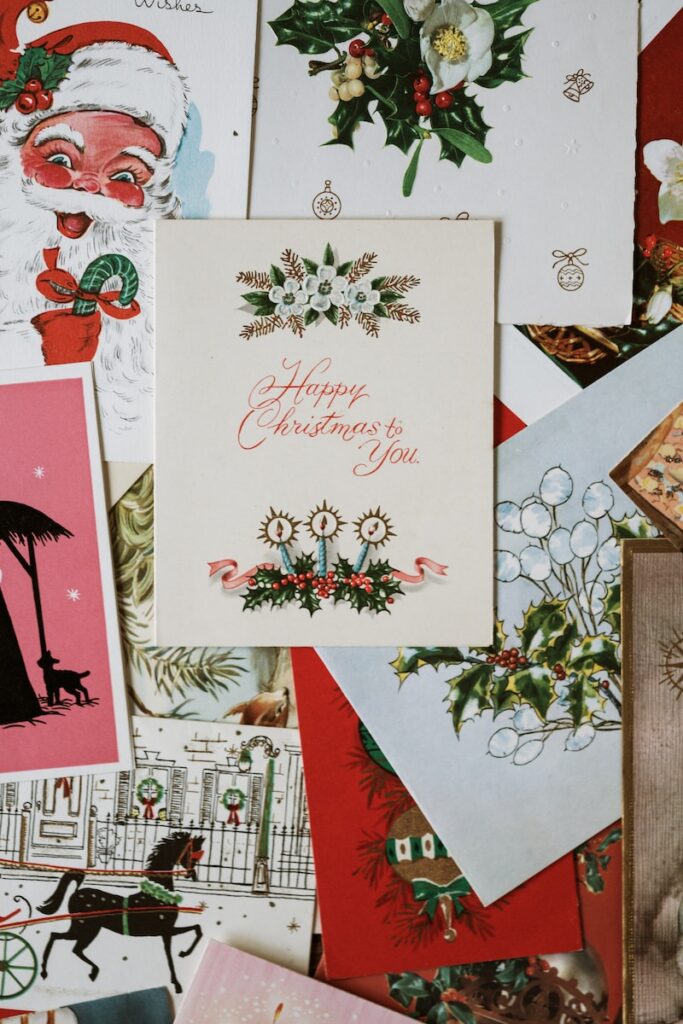
Deciphering the Chronicles of Christmas Cards
We may earn money or products from the companies mentioned in this post. This helps support what we do and in no way costs you a thing.
Have you ever pondered over the origin of those charming cards that grace our holiday season? Deciphering the chronicles of Christmas cards is as intricate as the emotions they carry. Let’s embark on a captivating voyage back in time to uncover the inception, evolution, and the profound personality traits that our card choices whisper to the world.

The Genesis of Christmas Cards: A Tale of Handwritten Warmth
The dawn of commercial Christmas cards emerged in 1843, the very year when Charles Dickens penned the iconic “A Christmas Carol.” Before this transformation, handwritten yuletide greetings, exchanged in person or through mail, carried the warmth of personal connections and heartfelt sentiments.
Crafting Innovation: Sir Henry Cole and John Callcott Horsley
A revolutionary moment was ignited by Sir Henry Cole, a British visionary with a desire to share festive cheer in an elegant manner. Collaborating with artist John Callcott Horsley, they birthed a triptych design adorned with benevolent acts. This marked the turning point that transformed a simple act into a widespread tradition.
Themes, Trends, and Louis Prang’s Artistic Wave
Themes in Christmas cards underwent a splendid metamorphosis. Early cards bloomed with flowers, fairies, and fanciful motifs, evoking the promise of spring. The latter part of the 19th century introduced Americans to the concept, championed by the creative Louis Prang. His exquisite floral compositions paved the way for later iconic imagery.
Today’s Landscape of Christmas Cards: A Modern Chronicle
Fast forward to the present, where more than two billion Christmas cards are exchanged annually in the United States. The introduction of Canada’s first Christmas stamp in 1898 marked another milestone, and the UK’s tradition of delivering cards on Christmas morning added a touch of magic. Yet, in the digital era, the number of physical cards has seen a gradual decline.
Decrypting Personalities Through Card Preferences
Beyond history, our choice of cards provides a captivating window into our personalities. Modern cards often mirror extroverted traits, coupled with an affinity for unconventional thinking. Humorous cards hint at outgoing and emotionally secure individuals, albeit with a dash of detachment. Traditional cards resonate with bookish inclinations and emotional intensity, while abstract cards capture spontaneity and an aversion to rigid structures.

What do your Christmas cards reveal about your personality?
- Modern cards: Extroverted and enthusiastic about life, although somewhat anxious and easily upset, with a tendency to be more creative and unconventional than most.
- Humorous cards: Outgoing and emotionally secure, but with a distinct lack of warmth and sympathy for others.
- Traditional cards: People who prefer reading a good book to a night out on the town, with a tendency to experience extremes of emotions, and follow the rules.
- Abstract cards: Tendency to be disorganized and spontaneous, highly strung, and a low need to surround themselves with others
- Cute cards: Sympathetic, calm and open to new experiences, and with a tendency to prefer one’s own company to others.
- Religious cards: Emotionally stable, sympathetic to the needs of others, and well-organized.
The Language of Cards, A Narrative of Souls
As we reflect on the journey from handwritten greetings to the digital age, we recognize that every card carries more than just a festive wish. Within it resides history, innovation, and a tapestry of human characteristics that form our individuality.
Whether we’re extroverted advocates of modernity or tranquil admirers of religious symbolism, each card we send or receive weaves a chapter into the timeless tale of human connection, ingenuity, and the essence of the holiday spirit. It’s a testament that even in a world transformed by technology, the age-old tradition of sharing sentiments endures as a beacon of our distinctiveness and the magic of the holiday season.
Quick Facts About Christmas Cards
- Christmas cards were not the first greetings cards. Since 1796, with improvements in printing, merchants had been sending cards to their customers offering “best wishes” for the new year.
- In the nineteenth century, the British Post Office used to deliver cards on Christmas morning.
- The first Christmas stamp was released in Canada in 1898.
- The average person in Britain sends 50 Christmas cards each year.
- Only one in 100 Christmas cards sold in Britain contains any religious imagery or message, a Daily Mail survey has revealed.

FAQs about Deciphering the Chronicles of Christmas Cards
How did Christmas cards evolve over time?
Early Christmas cards favored floral and fanciful designs, often emphasizing the approach of spring rather than winter themes. In the late 19th century, American lithographer Louis Prang introduced high-quality cards featuring floral arrangements. Eventually, cards started featuring more iconic symbols such as the Madonna and Child, decorated trees, and Santa Claus. Deciphering the chronicles of Christmas cards is fascinating and to be enjoyed by all member of your family no matter their age.
What is the significance of the Christmas card’s inscription “Merry Christmas”?
The term “merry” in the phrase “merry Christmas” originated as a spiritual word meaning “blessed.” It was akin to the phrase “merry old England.” The inscription encapsulates the traditional well-wishing for a joyful and blessed Christmas and New Year.
How did Christmas cards become popular in the United States?
While printed Christmas cards gained popularity in England and Germany, it took approximately thirty more years for the idea to catch on in the United States. In 1875, Boston lithographer Louis Prang, hailed as the “father of the American Christmas card,” began publishing cards. Prang’s influence played a significant role in introducing Americans to the tradition.
How has the digital era affected the exchange of Christmas cards?
In the modern digital age, the exchange of physical Christmas cards has seen a decline due to the convenience of email and telephones. While over two billion Christmas cards are still exchanged annually in the United States, the availability of free email Christmas cards and the ease of digital communication have impacted the tradition.

